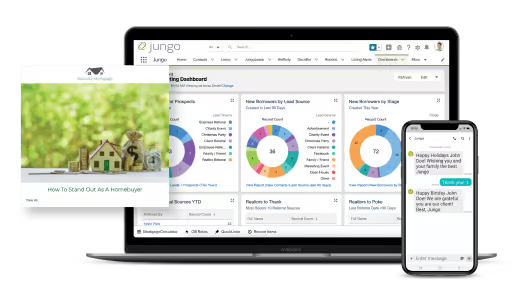Chapter 1
What Is Mortgage Marketing?
Chapter 2
Loan Officer Marketing Plan Template
What is a Loan Officer Marketing Plan?
How to Develop a Loan Officer Marketing Plan Template
Find Your Target Audience or Niche
Develop a Buyer Persona for Your Target Market
Cultivate Relationships to Build a Quality Database
Chapter 3
Effective Digital Mortgage Marketing Strategies
Chapter 4
Loan Officer & Mortgage Broker SEO Strategies
Chapter 5
Loan Officer Marketing to Realtors
In the first chapter of our Mortgage Marketing Guide, you learned the definition of mortgage marketing, the types of marketing, and the stages of the mortgage marketing process. Now, it’s time to put this information into a detailed loan officer marketing plan to entice and obtain new business. In this chapter, we will define what a marketing plan is and explain how you can use Jungo’s free loan officer marketing plan template to create one for your mortgage business.
What Is a Loan Officer Marketing Plan?
A loan officer marketing plan communicates your business goals and identifies the marketing tactics you will use to reach them. A solid mortgage marketing plan will identify the business’s target market, its value proposition, and its competitive advantage in the market. Additionally, a mortgage marketing plan should outline the marketing goals of the business, the tactics it will use to achieve them, and how it will measure the performance of its marketing campaigns.
How To Develop a Loan Officer Marketing Plan Template
Just like the many steps accompanying client loan processes, a thorough and valuable loan officer marketing plan also requires various tactics. Fortunately, most loan officers don’t need to create a strategy from total scratch. Instead, check out the following loan officer marketing plan template to streamline your efforts for maximum Return On Investment (ROI).
1. Find Your Target Audience or Niche
The first step in a loan officer marketing plan is identifying your target audience or niche. Marketing is most effective when it speaks to a specific audience. So, rather than focus on the entire mortgage industry, hone in on the individuals currently powering your business. These demographics help create a loan officer marketing plan template tailored to these specific customers.
For instance, when dealing with mortgage loans, it’s helpful to break the general audience into various borrower types. First-time homebuyers, refinance clients, and even low-credit loan seekers are niches. These can be hyper-targeted in a loan officer marketing plan. Alternatively, you can focus your target audience on particular loan types. Such as individuals seeking a VA home loan or investment property loan.
2. Develop a Buyer Persona for Your Target Market
A buyer persona is a fictional representation of your ideal customer. It puts a fictional face on your target audience. So, you can focus your time and resources on the type of content and verbiage your ideal client prefers. By creating a buyer persona, you can hyper-target your marketing efforts and determine which types of marketing, such as traditional marketing, digital marketing, or referral marketing, is best for reaching your audience.
To develop a buyer persona, take a deep dive into previous client data and identify which client types are the most successful (and enjoyable). Leverage this information. Along with demographics such as household size and annual salary range, create a persona for each of your desired niches. What does each persona want and need from a loan officer?
Buyer Persona Examples
For instance, ‘First Time Buyer Bob’ can encapsulate the preferences and finances of a new buyer. Also, ‘Refinance Rita’ can sum up the details of a client looking for refinancing. Each time you create new marketing materials or communicate with a potential client, return to these personas to ensure your messaging and positioning match their current needs, wants, and preferences.
3. Perform a SWOT Analysis
With your target audience in mind, the next step in a loan officer marketing plan template is to perform a SWOT analysis. Short for Strengths, Weaknesses, Opportunities, and Threats, a SWOT analysis is a critical marketing practice. So, it helps businesses identify and assess various factors. These can either positively or negatively impact their clients’ goals.
In terms of a loan officer marketing plan, the acronym SWOT can be broken into:
- S: Areas of strength you and/or your mortgage company perform well in along with your competitive advantages, such as strong communicative skills.
- W: Areas of personal weakness that your competitors have an advantage in, as well as areas where you are limited by resources or inexperience, such as clerical skills.
- O: Present market opportunities or trends in your local area that you can capitalize on with your strengths.
- T: Present threats in the current housing market that could impact your marketing plans, such as COVID-19, increased competition, and new regulations.
By completing a SWOT analysis, loan businesses can better prepare for both potential advantages and disadvantages in their marketing plans.
4. Develop a Value Proposition
In the increasingly competitive mortgage industry, loan officers need to understand the importance of a value proposition. A value proposition is a simple statement that sums up why a potential client should choose your specific service. The basis of a value proposition is always your customer’s main problem. So, to formulate yours, return to your buyer persona to identify your customer’s primary problem or need.
Next, review your SWOT analysis to identify your strengths and how these strengths can be valuable to your target audience. For instance, strong communication and intrapersonal skills are valuable to ‘First Time Buyer Bob’ who doesn’t understand how home loans work. Also, position this information to differentiate yourself from your competitors. This develops your unique value proposition.
5. Define Your Goals
Goals are the backbone of a loan officer marketing plan template. Without goals, none of your marketing efforts have a true purpose or a means of measurement. So, when defining your goals, it’s important to explain what you want to accomplish and how you plan on getting there. What do you need to do differently to execute your loan officer marketing plan?
For example, perhaps you’d like to increase your brand awareness and solidify your reputation in your local community. Then you might decide to dedicate part of your marketing budget to your Search Engine Optimization (SEO) efforts to help your website rank higher in search results and outperform your competitors. Decide what your goal is, and write down the steps you need to take to make it happen.
Ask Questions
Whatever you decide to do differently, make sure that your goals are trackable and specific. Otherwise, you’ll never be able to tell if you’re truly hitting your benchmarks. Check in on your loan officer marketing plan regularly. Are you missing, hitting, or surpassing your goals? Do you need to adjust your methods? After all, what you do now determines where you will be later.
6. Cultivate Relationships To Build a Quality Database
So, have your goals and value proposition in mind. Then, you can decide how to optimize the gap between where you are now and where you’d like to be. While you may think cultivating new relationships is a challenge, it’s something that needs to be done to reach your marketing goals.
Fortunately, building and maintaining customer relationships does not need to be as intimidating as you may think. The right Mortgage Customer Relationship Management (CRM) tool can help loan officers stay in touch with clients throughout the entire buying process, all from one convenient dashboard. Jungo’s Mortgage CRM software offers robust capabilities to manage customer data, send SMS text messages, and automate email communications to effortlessly meet your marketing goals.
7. Create Partnerships with Referral Partners
The massive size of the real estate market means countless other professionals understand and value your work. Not all of them are your competition! If you want your loan officer marketing plan template to take on a life of its own, you’ll need to support your business growth by creating partnerships with referral partners.
Creating strong partnerships with fellow industry professionals, such as real estate agents, allows loan officers the opportunity to give and receive beneficial referrals. Jungo’s co-marketing tools help attract and build these profitable partnerships. These use aesthetically appealing email templates, flyers, and post-closing cards/gift packages. The costs and performance of these various referral partner marketing materials can also be easily tracked using customizable reporting capabilities.
8. Provide Ongoing Value
All in all, this loan officer marketing plan template is a great source of starter knowledge for you and your ongoing future as a mortgage loan officer. As you continue to navigate which marketing efforts work best for you and your target audience, you must remember that existing and potential clients may also need a bit of industry knowledge to also help guide their processes.
Fortunately, it’s easier than ever to disseminate helpful industry information with the right marketing tools. Loan officers can provide a variety of mortgage loan industry topics. These appeal to existing and potential customers via email and video marketing. Also, position yourself as a leader in your field. These marketing materials also speak to the quality of your business, which can benefit overall lead generation.
Bottom Line
Know you know the ins and outs of developing a loan officer marketing plan for your business. Let’s recap what we’ve learned in this chapter:
- A loan officer marketing plan provides an overview of your business goals and the marketing tactics you will utilize to reach them.
- To create your marketing plan, you must identify your target market and understand what they are looking for in a mortgage solution.
- With your target market in mind, you can conduct a SWOT analysis of your business and its competitive landscape to determine where your advantage is in the market.
- Leverage your competitive advantage (the thing your mortgage business does well) into your value proposition to reach your audience by speaking to their needs.
- Define the goals of your marketing efforts and the marketing tactics you will use to achieve them. Make sure your marketing campaigns are measurable.
- A Mortgage CRM with marketing automation features is crucial to managing your relationships with leads, prospects, clients, and referral partners and ensuring you provide value at every step.
While this loan officer marketing plan template is an excellent guide on where to start with your efforts, it’s not the guarantee of complete marketing success. In reality, loan officer marketing features a good deal of trial and error. As you continue to experiment with a variety of marketing tactics, you’ll eventually identify what works best for your and your target audience. In Chapter 3, we will discuss digital mortgage marketing strategies and how you can leverage digital channels to drive new qualified leads.
Previous
Chapter 1
What Is Mortgage Marketing?
Next
Chapter 3
Effective Digital Mortgage Marketing Strategies











